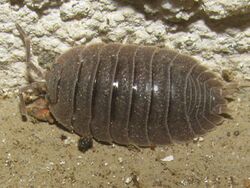Biology:Porcellio dilatatus
From HandWiki
Short description: Species of woodlouse
| Porcellio dilatatus | |
|---|---|

| |
| Scientific classification | |
| Domain: | Eukaryota |
| Kingdom: | Animalia |
| Phylum: | Arthropoda |
| Class: | Malacostraca |
| Superorder: | Peracarida |
| Order: | Isopoda |
| Suborder: | Oniscidea |
| Family: | Porcellionidae |
| Genus: | Porcellio |
| Species: | P. dilatatus
|
| Binomial name | |
| Porcellio dilatatus Brandt, 1833
| |
Porcellio dilatatus (Commonly known as the Giant canyon isopod) is a species of woodlouse in the genus Porcellio belonging to the family Porcellionidae. This species is widespread in Europe,[1] and has also been introduced to North America from Western Europe.[2] They are 15 millimetres (0.59 in) long, are brown coloured and striped.[3] They can be found feeding on alder leaves,[4] but mostly feeds on organic food substrates, such as lettuce (Lactuca sativa) in the wild. It also feeds on inorganic metal salts.[5]
Pests
The species are considered to be house pests, that can be found in greenhouses, seed boxes, and flower pots.[3]
Subspecies
Five subspecies are recognised:[6]
- Porcellio dilatatus bonadonai Vandel, 1951
- Porcellio dilatatus dilatatus Brandt, 1833
- Porcellio dilatatus flavus Collinge, 1917
- Porcellio dilatatus petiti Vandel, 1951
- Porcellio dilatatus rufobrunneus Collinge, 1918
References
- ↑ "Porcellio dilatatus Brandt, 1833". Fauna Europaea. August 29, 2013. http://www.faunaeur.org/full_results.php?id=218516. Retrieved October 12, 2013.
- ↑ Poore, G.C.B. (2002) (PDF). Zoological Catalogue of Australia. CSIRO Publishing. p. 308. ISBN 978-0-643-06901-5. https://books.google.com/books?id=ww6RzBz42-4C&dq=Porcellio+dilatatus&pg=PA308.
- ↑ 3.0 3.1 David V. Alford (2012). "4". Pests of Ornamental Trees, Shrubs and Flowers - A Colour Handbook (2nd ed.). Manson Publishing. p. 435. ISBN 978-1-84076-162-7. https://books.google.com/books?id=AUqYrRc8-AcC&dq=Porcellio+dilatatus&pg=PA435.
- ↑ Isabel Caseiro; S. Santos; J. P. Sousa; A. J. A. Nogueira; A. M. V. M. Soares (2000). "Optimization of culture conditions of Porcellio dilatatus (Crustacea: Isopoda) for laboratory test development". Ecotoxicology and Environmental Safety 47 (3): 285–291. doi:10.1006/eesa.2000.1982. PMID 11139182. https://bibliotecadigital.ipb.pt/bitstream/10198/849/1/Optimization%20of%20culture%20conditions%20of%20Porcellio%20dilatatus.pdf.
- ↑ Carla Filipa Calhôa; Amadeu M. V. M. Soares; Reinier M. Mann (2006). "Cadmium assimilation in the terrestrial isopod, Porcellio dilatatus – is trophic transfer important?". Science of the Total Environment 371 (1–3): 206–213. doi:10.1016/j.scitotenv.2006.09.013. PMID 17055036.
- ↑ Marilyn Schotte (2012). "Porcellio dilatatus Brandt, 1833". World Marine, Freshwater and Terrestrial Isopod Crustaceans database. World Register of Marine Species. http://www.marinespecies.org/aphia.php?p=taxdetails&id=262272.
Wikidata ☰ Q82885 entry
 |

